My classes this year are large–ranging from 30-35 each period, including my two AP Language & Culture blocks. Relationship building is essential for any class, but I feel it is particularly important in my large AP classes. Since I am dramatically outnumbered, I need them to work together, trust one another, and feel comfortable together. Our school has over 2000 students, so the first days are critical for building community because (unlike the tiny high school I attended back in the day) they don’t all know each other.
Taking a page from the Persona Especial/Estrella del Día techniques that I use in my lower level classes, we will start our class with small group interviews. Students will be choose their own seats, and then work with groups of about 3-4 sitting near them. Using the first page of this handout (AP cooperative group profiles) as a guide, they will interview each other in Spanish and take notes accordingly. This gives me a few minutes to mingle and listen on the first day, and it gives them a low(er)-stress environment to interact in TL. Afterwards, we will use some PQA to get to know each other a bit and to model some aspects of what to expect in class this year. These groups will be their base groups for activities throughout the month. We are on an A/B schedule, so a month of working together is about 10-12 classes.
The final touch is on the back of the page. After working together in these collaborative groups for the month, we take a few moments to celebrate and encourage. Each student will give his/her paper to another in the group, who will fill out the first box, then rotate, continuing until everyone in the group has had a chance to write affirmations and encouragement on each others’ papers. Each student receives his/her paper back with positive vibes provided by the others from the group. The next class–coinciding with the new month–we arrange new groups with some different questions in the new chart, and the process begins again.
I know this idea originally came from another teacher, but I cannot locate the reference. If you know, please tell me!!





